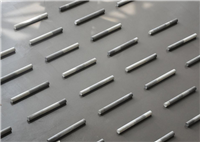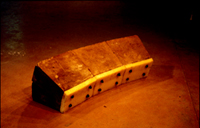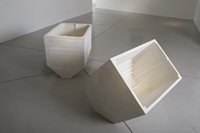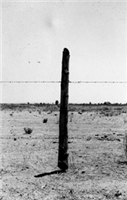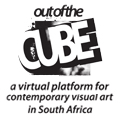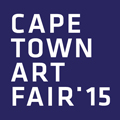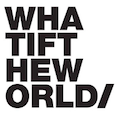Current Review(s)
'Structure'
Jeremy Wafer at KZNSA
The Structure of Things
Peter Machen talks to acclaimed former Durban artist Jeremy Wafer, who was back in his home town recently with a retrospective exhibition at the KZNSA Gallery.
Peter Machen: Hi Jeremy. Firstly, what led you in the aesthetic and conceptual direction you have taken over the course of your career? Do you think that you would have produced similar work if you hadn't lived in Durban? And do you think that you were influenced to any degree by the pseudo-Soviet aesthetic of the old South Africa?
Jeremy Wafer: A big question which involves one's whole biography probably! The work of artists I was looking at in art magazines in the 70’s – Carl Andre, Eva Hesse, Mary Miss, conceptual art, land artists digging holes in the ground, photographing water towers etc. – All this seemed to offer a different way of being after the bleakness of school and army.
My work has been very much about place: the industrial Jo'burg landscape of mine shafts and dumps, the richness of Durban: Cato Manor temples, Maydon Wharf, the pier, Warwick Triangle. I don’t know about the aesthetic of the old South Africa but I love the Soviet artists Tatlin and Rodchenko. I think one's sensibility is formed in place and time. I was born in Durban and spent my first year or so in the naval barracks on the Bluff, then boarding school, and later teaching at Tech for about 20 years.
PM: Many of your works have a strange dual effect on me. On one hand, the singularity of the work suggests to me a certain brutality and violence; and at exactly the same time, I find the work transcendent, almost peaceful. I have the same response to freeway interchanges, cooling towers, water towers and highways. Is my response to your work a common one, and is it any way part of your intention?
JW: I am drawn to things which have a plain functionality, not just in a modernist form/function way, but the directness of ordinary things like warehouses, bridges, containers etc. I don’t always know what my intention is but I do like a wall to be wall, a cube a cube, a hole a hole etc. And I do see these as somehow fundamental qualities. It is a quick slide from fundamental/ essential to metaphysical perhaps. It's always a bit awkward using terms such as ‘transcendent’ but maybe there is something in the ‘truth=beauty=truth’ thing. (Or maybe its just a Catholic upbringing!)
16 August 2009 - 05 September 2009
Listings(s)
'Structure'
Jeremy Wafer at KZNSAThis exhibition and the companion publication of the same name traces the artist’s production over a period of 25 years. The project starts by assuming that geometry is underlined by something greater than numbers, measurements, angles, trigonometry and the immediate beauty that originates from these applications of mathematics. It tries to fathom, beyond the strictly austere and the exactingly severe, the variability of emotions that function beneath the form.
16 August 2009 - 05 September 2009
'Next Generation'
John Murray, Ruan Hoffmann, Dineo Seshee Bopape, Hasan and Husain Essop, Santu Mofokeng, Jeremy Wafer, Zanele Muholi, Clifford Charles, Nicholas Hlobo and Ndikhumbule Ngqinambi at Pilchri StudioIn 1993 the Thami Mnyele Foundation initiated the exhibition 'Zuider Kruis/ Southern Cross' in Stedelijk Museum Amsterdam, an exhibition of contemporary art from South Africa with artists who had been taking part in the Venice Biennial the previous year. Now 19 years later, the Thami Mnyele Foundation exhibits the work of a new generation of artists from South Africa in cooperation with the Pulchri Studio in The Hague. 'Next Generation' presents a selection of 20 contemporary artists from South Africa who have been working in the Thami Mnyele Foundation as 'Artist-in-Residence' during the past years.
Artists include: Hasan and Husain Essop, Michele Tabor, Ina van Zyl, Sandra Kriel, Ndikhumbule Ngqinambi, Adriaan de Villiers, Ruan Hoffmann, Zanele Muholi, Dineo Bopape, Clifford Charles, Thulani Shongwe, Nicolas Hlobo, John Murray, Senzeni Maracela, Jeremy Wafer, Shepard Mtyshelwa, Progress Matubako, Pat Mautloa and the work of the current resident Nisren Abasher, a Sudanese artist. It also encompasses the work of the Artist-in-Residence for June to July 2012: Santu Mofokeng.
02 June 2012 - 22 July 2012
'Structures'
David Goldblatt, Carlos Garaicoa, Jeremy Wafer, Oliver Chanarin and Adam Broomberg and Mikhael Subotzky at Goodman GalleryGoodman Gallery Cape Town presents 'Structures', a group exhibition bringing together works by Adam Broomberg and Oliver Chanarin, Carlos Garaicoa, David Goldblatt, Mikhael Subotzky and Jeremy Wafer. The exhibition is concerned with structures both monumental and mundane, and aims to examine the ways in which they inform the environments we inhabit, and what they suggest about the underlying systems that give rise to them.
David Goldblatt's series 'South Africa: The Structure of Things Then' deals in part with the architectural landscape of Apartheid South Africa and the relationship between the governing ideology of the time and its physical manifestations across the country. Mikhael Subotzky's ongoing 'Security' series is in some ways a contemporary response, documenting the surveillance cameras, security huts and electrified fences of the modern suburban landscape, and examining the links between poverty, race, crime and the effects of a legacy of discriminatory spatial planning.
Bertolt Brecht's 'War Primer' is a book of what Brecht called 'photo-epigrams': newspaper and magazine clippings of images of the Second World War, each captioned with a 4-line poem. In 'Poor Monuments', Adam Broomberg and Oliver Chanarin juxtapose pages from Brecht's original book with images of modern conflicts (in particular the so-called War on Terror) to look at the changing (and sometimes unchanging) narrative of war, and the systems responsible for crafting and disseminating it.
Cuban-born Carlos Garacioa's 'Para transformer la palabra polv?tica en hechos, finalmente II' (To transform political speech into facts, finally) takes as its subject the city as a site for collective memory and imagination, while a new floor sculpture by Jeremy Wafer contemplates abstract and physical notions of space, and the degree to which a space is produced by the structures it contains.
04 May 2013 - 01 June 2013
'Survey'
Jeremy Wafer at Wits Art Museum
Wits Art Museum is privileged to host 'Survey', an exhibition of major new work in sculpture, drawing and photography by Jeremy Wafer. Wafer is Professor of Fine Art at Wits University and a prominent and highly regarded contemporary South African artist. This exhibition is part of an academic project in which he reflects on a 30 year career of art making and which traces, revisits and re-articulates themes and ways of working which have characterized his work over this time.
04 September 2013 - 03 November 2013

